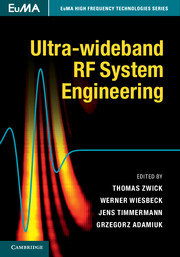3 - UWB antennas
Published online by Cambridge University Press: 05 December 2013
Summary
UWB antenna measurement methods
The methods for measuring antenna transfer functions with a network analyzer presented in the following use typically available measurement equipment for far-field antenna measurements with enhanced calibration procedures. The latter are necessary in order to obtain stable and consistent phase information for the transfer function in co- and cross-polarization. These methods complement the standardized antenna measurements known from [68]. A validation of the methods is presented with the prediction of a time domain impulse transmission, which is measured independently with a fast-pulse generator and an oscilloscope.
A prerequisite for the measurements is a stable measurement setup inside an anechoic chamber, which provides low reflections from the walls within the frequency range of operation. If multiple reflections cannot be avoided, the possibility of time gating for valid signals of the additional delay – due to the path lengths of wall or floor reflected signals – needs careful consideration. If the expected τr or even τFWHM overlap with the multiple reflections, the impulse response hAUT of the antenna under test (AUT) can no longer be measured accurately. Furthermore, far-field conditions are necessary in order to obtain a distance-independent impulse response estimation hAUT. The frequency domain far-field criterion r > (2D2)/λ (according to [24]) then applies for the highest frequency, i.e. the smallest wavelength.
- Type
- Chapter
- Information
- Ultra-wideband RF System Engineering , pp. 36 - 76Publisher: Cambridge University PressPrint publication year: 2013

